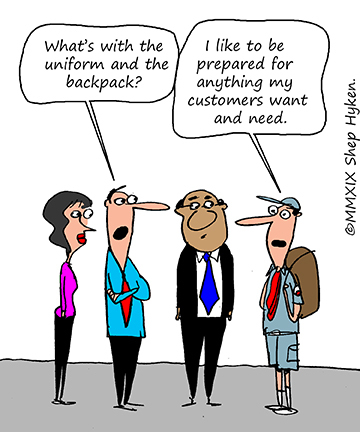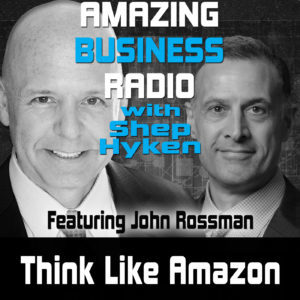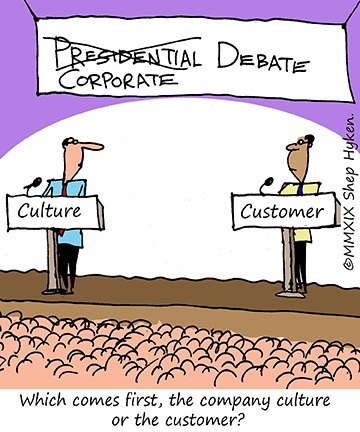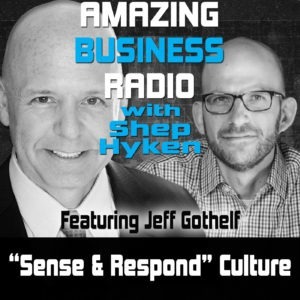Shep Hyken's Blog, page 121
August 21, 2019
What Can You Do To Create a Better Experience For Your Customers?
 If you’ve ever seen one of my speaking presentations, you’ve most likely heard my story about my favorite cab driver. It is an example of excellent customer service. It’s universal—I don’t know of anyone that hasn’t been in a taxi. If for some reason they haven’t, I can’t imagine they don’t know what one is.
If you’ve ever seen one of my speaking presentations, you’ve most likely heard my story about my favorite cab driver. It is an example of excellent customer service. It’s universal—I don’t know of anyone that hasn’t been in a taxi. If for some reason they haven’t, I can’t imagine they don’t know what one is.
In the story, I talk about the “amenities” the driver offered, which made me want to ride with him the next time I was in his city. These included complimentary soda, newspapers and a quick side trip to see a famous local attraction – at no extra charge. I also received a surprise thank you note four days after the trip.
Last week my friend, Ron Prather, sent me an article from HyreCar entitled, “15 Things Every Uber & Lyft Driver Should Keep In Their Car.” Some items were business necessities—a spare tire kit, the right kind of insurance and more. Then there were other “should haves” that might make the customer’s experience better. Some of those include:
Air freshener to make your car smell nice
A snack box to give your customers a little something they weren’t expecting
Auxiliary cords for passengers to charge their phones
Sanitary wipes, paper towels and cleaning supplies
First aid kit—just in case
Water bottles to give to customers
And more!
You get the idea. The article made me think about how all businesses should have a “should have” list, especially if you want your customers to have a certain experience. I refer to this list as Customer-Focused Musts. It doesn’t have to be a tangible item, like a bottle of water or a tissue box. Maybe it’s a “must do,” such as returning a call in a timely manner. For example, a restaurant’s customer-focused list could (and should!) include clean restrooms, a warm greeting, clean dishes and silverware—and of course, good food. There are plenty of musts that could go on the list. These are just a few.
What would be on your list of customer-focused musts? You could discuss this at your next team or company meeting. Start by having everyone read the HyreCar article as a creative primer to get the conversation started. As mentioned, some of the 15 things in that article include things you need to run your business. What else can you do that focuses on your customers and their experience? What “amenities” might your customers appreciate? There’s nothing stopping you, so what are you waiting for? It’s time—and you must get customer-focused!
Shep Hyken is a customer service expert, keynote speaker, and New York Times bestselling business author. For information, contact 314-692-2200 or www.hyken.com. For information on The Customer Focus customer service training programs, go to www.thecustomerfocus.com. Follow on Twitter: @Hyken
customer service training programs, go to www.thecustomerfocus.com. Follow on Twitter: @Hyken
(Copyright © MMXIX, Shep Hyken)
The post What Can You Do To Create a Better Experience For Your Customers? appeared first on Shep Hyken.
August 20, 2019
Amazing Business Radio: John Rossman
 Think Like Amazon
Think Like AmazonInnovation from the World’s Leading Customer-Obsessed Company
Shep Hyken interviews John Rossman. They discuss John’s new book, Think Like Amazon, and how to utilize the key factors that drive Amazon’s success.








The Interview with John Rossman:
Innovation and success come from developing and committing to systems. Be deliberate in how you approach your work and have a “playbook” you can pull from for any situation. Even though your business may change, a consistent system will drive you to success.
Identify the durable customer needs in your industry—the things customers will consistently desire and seek out from companies regardless of other changeable factors. For Amazon, these are low prices, large selection, and fast delivery. It’s helpful to phrase these needs as something like, “I can’t imagine a world where customers would want higher prices.”
Once you develop a core set of beliefs about your customers and brand, allow these to act as “swim lanes.” Focus on innovation within those areas; some ideas will work and some won’t, but you will learn from your mistakes. This approach will serve you well over a long period of time.
Most companies say they want to change, but very few companies are actually committed to following through with it. Change starts with being honest about who and what you are and whether or not you’re building for the future. Once you’ve done that, you can begin moving forward.
Are you a “day one company” or a “day two company”? Day one companies focus on tomorrow; lean forward and look at each day as a chance to grow and improve for the future. Day two companies focus on today; they maintain the status quo and optimize for the short term rather than the long term. They’re often more concerned about money than the customer.
A great way to drive change and innovation is to become customer-obsessed. When you’re obsessed, it drives you to do hard things on behalf of your customer. It can lead to more financial gain tomorrow.
Be relentless in your approach to innovation. Most innovation comes from every day, operational work. If you approach that relentlessly and put in the hours necessary, you will become better and make a positive impact on your customers.
Be willing to adopt change personally as well as professionally. Challenge your own internal status quo in addition to your company’s. This will help you go far.
Quotes:
“Change happens when leaders are willing to challenge their own personal status quo.” – John Rossman
“Most innovation comes from the hard work we do every day. Operational excellence is the feeding ground to drive innovation.” – John Rossman
“Experts make it look easy, but it’s only because they put in all the effort, practice, and skill development. They were relentless about improving their game.” – John Rossman
“When you’re obsessed, you’re willing to do hard things on behalf of your customer. Building a true customer obsession is a great way to challenge your status quo.” – John Rossman
“Innovation is not an accident. You have to develop a system.” – John Rossman
About:
John Rossman is the author of Think Like Amazon: 50 ½ Ideas to Become a Digital Leader. Formerly an executive at Amazon, he now heads Rossman Partners, a niche business advisory firm.
Shep Hyken is a customer service and experience expert, New York Times bestselling author, award-winning keynote speaker, and your host of Amazing Business Radio.
This episode of Amazing Business Radio with Shep Hyken answers the following questions … and more:
How can I be more like Amazon?
How can I become customer-obsessed?
How can I innovate like Amazon?
How do I achieve customer loyalty?
How do I make positive change within my organization?
The post Amazing Business Radio: John Rossman appeared first on Shep Hyken.
August 19, 2019
5 Top Customer Service Articles for the Week of August 19, 2019
Each week I read a number of customer service and customer experience articles from various resources. Here are my top five picks from last week. I have added my comment about each article and would like to hear what you think too.
Which is Your CX Priority: Satisfied Customers or Profit? by Mary Drumond
(LinkedIn) What should your ultimate goal be when designing your customers’ experiences? Well, you might assume the logical response to be “to have satisfied customers”. I, however, am not that sure.
My Comment: Someone once told me that if you chase profit over the customer, you may not get profit or the customer. But, if you chase the customer, you’ll most likely end up with both. The idea is that putting the customer before the sale is a good strategy. This article reminds of this strategy. Satisfied customers or profit. What’s your priority?
9 Customer Service Mistakes You Need to Stop Making by Kinga Odziemek
(G2 Crowd) Providing great customer service is not a choice or luxury; it’s a standard your customers expect.
My Comment: Most of the lists people compile (myself included) are how to’s. Well, here are nine “how to not’s” to consider in your customer service strategy. Some of these are pretty basic, but it’s the basics that can drive business. So, which one (or more) of these mistakes is your organization guilty of committing?
Only 8% of stores use live chat correctly, new report says by Kimberly Collins
(ClickZ) Customer service provider Simplr has released a new report on the most common customer service pitfalls among eCommerce brands. They look specifically at the customer service experience of 500 US-based brands in “high-growth mode” in the month of May 2019.
My Comment: Another list of mistakes to avoid… This one is focused on live chat and customer service in the retail industry. Even if you’re not in retail, you should read this article. It’s filled with information that will make you say to yourself, “We had better not be doing that.” Consider this little factoid. Email inquiries that had been redirected from a chat took an average response time of 20 hours – and some companies took more than two days! If live chat and chatbots are part of your customer service strategy, read this article.
Creating Company Culture to Strengthen Customer Service Agent Support by Cassandra Vincent
(Nevadas) There are ways to strengthen customer service agent support resulting in quality work and reducing churn. With excessive turnover in contact centers impacting metrics, keeping great agents is good ROI.
My Comment: Do you want better customer service? The first place to go is to the leadership. Have they helped to create the culture that fosters a better customer service experience? Yes, culture is the first step. Hiring right, having the right tools and more are good, but won’t be nearly as effective is what’s behind the scenes is the right culture to drive the experience.
3 Ways Marketing Creates Customer Experience Leadership by Lynn Hunsaker
(Clear Action) Marketing’s role in customer experience leadership can be powerful, especially if it’s managed holistically.
My Comment: It’s been said that customer experience is the new marketing. In many ways, it really is. The experience is what brings people back, and even better, gets them to talk about you to their friends and colleagues. (Of course, you want that experience to be good! Trust me when I tell you that if it’s bad, they will talk about that experience, too.) This article summarizes three strategies that will help you understand what goes into creating a good customer experience.
 Shep Hyken is a customer service expert, professional speaker and New York Times bestselling business author. For information on The Customer Focus
Shep Hyken is a customer service expert, professional speaker and New York Times bestselling business author. For information on The Customer Focus customer service training programs go to www.TheCustomerFocus.com. Follow on Twitter: @Hyken
customer service training programs go to www.TheCustomerFocus.com. Follow on Twitter: @Hyken
The post 5 Top Customer Service Articles for the Week of August 19, 2019 appeared first on Shep Hyken.
August 16, 2019
Guest Blog: 7 Games to Train Your Team’s Communication Skills
This week we feature an article by Michelle Jarsen who shares seven ways your support team can learn and practice essential communication skills.
Any job that involves interacting with people requires clear communication. It’s crucial that your support team learns and practices new ways of exchanging information and ideas.
Good communication isn’t a skill you’re born with or one that comes naturally. While there are plenty of things you can read and watch that might give you some tips and advice on how to communicate better, reading alone doesn’t cut it.
“The more your employees communicate, the faster their communication skills improve” . – Hugh Beaulac, MC2 Bid4Papers.
Instead, why not practice those skills in your team in a way that’s as fun as it is effective?
Games are an exciting way to improve communication skills and simultaneously improve team cohesion. Here are seven games your team can play to improve communication skills.
1. Blindfold Game
This game helps strengthen listening and speaking skills and improves trust.
What you need: ● 4 people or more ● Blindfolds ● An open space, like a private room, backyard or park
● Your choice of obstacles (boxes, chairs, a stack of books)
Directions: Make teams of two. Once you’ve decided which team will start, blindfold one member from that team. The other players can place obstacles in various spots throughout your space. Have the blindfolded member stand at the start of the course. The non-blindfolded member of the team must guide her through the course only by speaking.
This game improves cooperation and teamwork, as well as trust. When trust is lacking, the team won’t be as successful because the blindfolded person might be too suspicious and timid to move.
Clear communication is essential here because your team member is relying on you to guide her through the obstacles safely. This activity pushes you to choose your words carefully and to speak confidently.
Communicating clearly and effectively is key when working with customers. Clarity will help your team minimize confusion and assist customers fast and more successfully.
2. Crazy Comic
This is from the book “104 Activities That Build” by Alanna Jones. Crazy Comic targets teamwork, cooperation, coordination and creativity.
What you’ll need: ● 3 people or more ● Pencils or other drawing utensils of choice ● Paper
Directions: Divide each team evenly, depending on the number of players you have. Each group will create a comic strip, with the number of strips equivalent to the number of players in each team. Set aside time at the beginning of the game to discuss what the comic will be about and what each person will draw.
Agree on an amount of time that should be allotted for drawing. Seat team members far away from each other so that they aren’t able to see what the other person is drawing. When the time is up, assemble each comic and discuss how successful it was in sticking to your original plan.
Cooperation is a major part of this game since a leader isn’t chosen. The team members depend on each other to carry out a cohesive vision, which mimics the reality of working together in project teams.
This game mirrors what working in a digital environment is like where people aren’t always around to discuss each step of a process. By discussing the issues that arose during the game, you can better troubleshoot similar issues you might experience in the office.
3. Card Pieces
Card pieces is an easy game that helps develop negotiation skills and improve understanding and empathy.
What you need: ● 9 people or more ● Private room or space ● Triangle cards (use different colored paper, fold into a square and cut diagonally, then diagonally again) ● Plain envelopes
Directions: Divide groups of 3-4 people into at least three teams. Collect the triangle cards you’ve made, mix them up and divide them according to the number of teams you have. Place the cards in an envelope and give one to each team. Teams must negotiate and trade their pieces with each other to complete a square of one color. The team that has the most completed squares wins.
For this game, members must be able to trade with one another, which practices negotiation, listening and empathy. By working in groups, members must attempt to achieve the greatest good for their team, not for themselves.
After you’ve played the game, discuss which negotiation methods worked better and which didn’t work so well; try to come to an understanding of why some methods were stronger than the others. Also, talk about how you tried to see the game from someone else’s perspective to help you get more cards. Did you change communication methods depending on the person you were talking to? It’s important to see how communication techniques you use to talk to one person won’t necessarily work with another person.
4. Building Blocks
Building blocks work on your communication and teamwork skills and helps you learn how to give clear and descriptive instructions.
What you’ll need: ● At least 4 people for a team; only 1 team necessary ● Blocks or anything stackable (books, Tupperware, etc.) ● A table (if your stacking objects are small)
Directions: Give the team 2 sets of identical (or very similar) building blocks. Assign roles to each person on the team: a director, a builder, a runner and at least one or more as observers.
Have the director and builder stand on opposite sides of the room you’re in, facing away from each other. The director must build a unique structure using stackable objects. She will then give instructions to the runner on how to build that structure. The runner relays these directions to the builder. Meanwhile, the observer takes notes of what happens, like how the people communicate and listen to each other. Afterward, discuss what worked well and what didn’t.
Teamwork relies on proper cooperation and communication, which are crucial skills needed for completing tasks. This game allows members to be responsible for their own part in the task while relying on each other to complete the stack properly.
If you have enough people for more than one team, make it more competitive by creating more teams and have them work against time. If one team is smaller than the other, have the director give directions to the builder, eliminating the need for a runner.
5. Misunderstanding
Misunderstanding helps improve creative communication skills.
What you’ll need: ● 2 people or more ● Chairs ● Variety of objects ● Paper ● Writing utensils of your choice
Directions: This game will be done in groups of two. Have one person from the team choose an object without the other person seeing what she’s chosen. Have the two people sit back-to-back. The player with the object must describe it to the other person without naming it. The other player will then draw the object, based solely on the description given.
This game encourages you to be creative with your words and descriptions, and it creates insights for the players on how easy it is to misunderstand one another. Players must search for new, vivid ways to describe the object so that their partners can get a clear idea of it without seeing or touching it. This is a great way of improving communication that isn’t face-to-face.
To make it slightly more challenging with larger groups, make it a competition. The duo with the most accurate drawing wins.
6. Four at a Time
This activity works on teamwork and non-verbal communication.
What you’ll need: ● 5 people or more ● Number of chairs equal to players ● Private space
Directions: The goal of the game is to have exactly four people standing at all times and to keep the game going for as long as possible. Participants should sit themselves in a circle. Each person stands for 10 seconds. After the 10 seconds are over, the people standing must sit down and be replaced by new people. Communication within the circle must be non-verbal; no speaking is allowed.
Non-verbal communication skills are essential for in-person customer service. This kind of game would be great for pre-sales support teams, who work together to boost customer engagement.
A great thing about this game is that it can be played anywhere – simply leave the chairs out if you don’t have them available. This game works well with larger groups, which makes it more fun and challenging.
7. Get It Together
Get It Together improves focus and strengthens your ability to give clear directions, while encouraging teamwork.
What you’ll need: ● 4 people or more ● Blindfolds ● Masking or colored tape ● Various small items ● Open area or room
Directions: Create a circle in the center of the space using the tape. Divide the players into teams of two, blindfolding one member from each team. Place the objects you’ve picked out in the center of the circle. Have the non-blindfolded member from each team direct the blindfolded member to retrieve a specific object in the circle. Make sure that the person giving instructions doesn’t enter the circle. With more teams, the game becomes complicated as multiple people enter the circle.
The game encourages focus since players have to carefully guide their partners to retrieve the correct object. Whether you’re speaking with a colleague or a customer, every team member must be able to practice focus and concentration.
Switch roles after each round to experience both sides of the game. You can then discuss different methods each team used to guide their partners.
From professional to private life, communication is integral. You can improve your skills over time and develop a clear, simple way to communicate. Games are a great way to practice because not only do you get to have fun, you’re also learning along the way. Use these games to bring your team closer and work on your communication skills together.
Michelle Jarsen is part of the Marketing Team at Userlike, software for website and messaging support. We share tips about customer service and communication on the Userlike Blog.
For more articles from Shep Hyken and his guest contributors go to customerserviceblog.com.

Read Shep’s latest Forbes article: Unethical Marketing Destroys Customer Experience And Brand Reputation
The post Guest Blog: 7 Games to Train Your Team’s Communication Skills appeared first on Shep Hyken.
August 14, 2019
Winning Decisions Are Sometimes Tough Decisions
 I enjoy going to a baseball game. I live in St. Louis, and the fans of the St. Louis Cardinals are known throughout the sports world as being some of the best fans in all of baseball.
I enjoy going to a baseball game. I live in St. Louis, and the fans of the St. Louis Cardinals are known throughout the sports world as being some of the best fans in all of baseball.
Many fans remember Albert Pujols as one of the most skilled—not to mention beloved—members of the St. Louis Cardinals team. He was one of our best—and still is one of the best to ever play the game. The fans loved him, and he loved our city. But eight years ago, he left the Cardinals to play for the California Angels. Why did Pujols leave? The Angels offered him LOTS of money and the Cardinals wouldn’t match the offer. It was a sad day when Albert left St. Louis.
Last month, the Angels came to St. Louis to compete against the Cardinals—and Pujols came with them, after eight years away. One might expect some tension surrounding his homecoming. But when Albert took the field, he was met with a prolonged standing ovation. What’s more, when he hit a home run against the Cardinals, he received an even longer-standing ovation. What fans of any sport celebrate the opposition scoring against them in that way?!
I bring all this up because it was a difficult decision to let Albert leave. The Cardinals could have matched the offer but chose to invest in the team differently. It was a purely a business decision—a tough business decision. The Cardinal’s leadership team knew how the fans would react—negatively—but as tough as the decision was to make, it was the right one for the team.
Yes, some decisions are tough. But no venture ever achieved success without facing tough decisions. For instance, if the wrong person is in a customer-facing position and they don’t properly manage a customer’s experience, it could create problems. What makes it extra tough is that this person has been with the company for a long time and is a loyal employee. Should they be fired? They’re clearly not meant to be on the front line. Maybe there is a better opportunity that is more suited to that employee’s personality. It may be time to move them to a different position. Regardless, the decision has to be made.
Consider this. Let’s say you have 100 employees and 99 of them are amazing. But there’s one person who doesn’t understand the importance of being customer-focused. They don’t return calls or emails quickly. They are sometimes a little curt or short-tempered with customers. Here’s the really bad thing… their boss knows it—but won’t do anything about it. Rather than deciding to move this person to a different position or out of the company permanently, it seems easier to hope they get better.
Two things. First, hope is not a strategy. You can’t just “hope” it gets better. Nothing gets better without effort. Second, even though you have 99 out of 100 rock star employees, if your customer talks to the one that’s less than stellar, that’s the impression your customer will have of your entire company. When you understand the problem, the decision may not seem so tough after all.
If you want to compete in business, you must make good decisions—often tough decisions—that will put your organization in a position to win.
Shep Hyken is a customer service expert, keynote speaker, and New York Times bestselling business author. For information, contact 314-692-2200 or www.hyken.com. For information on The Customer Focus customer service training programs, go to www.thecustomerfocus.com. Follow on Twitter: @Hyken
customer service training programs, go to www.thecustomerfocus.com. Follow on Twitter: @Hyken
The post Winning Decisions Are Sometimes Tough Decisions appeared first on Shep Hyken.
August 13, 2019
Amazing Business Radio: Jim Tincher
 Mapping the Customer Journey
Mapping the Customer JourneyUnderstanding Every Interaction to Create the Best Customer Experience
Shep Hyken interviews Jim Tincher. They discuss journey mapping and how it can be used to improve both the employee experience and the customer experience.








The Interview with Jim Tincher:
What is a journey map? A journey map is a graphic representation of every interaction a customer has with you and your business. Journey maps can be used as effective tools to drive change and improve the customer experience.
It is important to make the journey map highly visual. This will help people remember the key points and takeaways, which will help drive the positive changes that are needed in your organization.
Jan Carlzon coined the phrase “Moment of Truth,” which is any and every interaction the customer has with an organization that gives them the opportunity to form an impression. These points of contact can come in many varieties, and they all form part of the customer journey.
One of the biggest touchpoints is actually Google, which allows customers to form an impression of your company before interacting with it directly. This is a good reminder that much of the customer journey may not directly involve your company, but it still forms an important part of the bigger picture.
Before you begin journey mapping, there are five questions you should ask and answer:
What’s the problem you want to solve?
What’s the right journey for your customers/business?
Who is the customer?
How do you get customer feedback?
Who is on your team?
It’s crucial to obtain feedback and get your employees to listen to the customer. And once you get that feedback, you must do something with it. If you don’t, you will betray your customers’ trust and ruin the relationship.
In addition to mapping the customer journey, it’s also advisable to map the employee journey. The employee journey behind the scenes has direct impact on the customer.
Quotes:
“The best way to destroy a customer relationship is to ask for feedback and do nothing with it.” – Jim Tincher
“You can’t create a great customer experience if you have a terrible employee experience.” – Jim Tincher
“You can spend all your time focusing on the customers, but if you don’t enable (empower) your employees to create a great customer experience, it’s going to be a long road.” – Jim Tincher
About:
Jim Tincher is the founder and Mapper-In-Chief at Heart of the Customer. He co-authored the recent book How Hard Is It to Be Your Customer? Using Journey Mapping to Drive Customer-Focused Change.
Shep Hyken is a customer service and experience expert, New York Times bestselling author, award-winning keynote speaker, and your host of Amazing Business Radio.
This episode of Amazing Business Radio with Shep Hyken answers the following questions … and more:
What is journey mapping?
Why should I create a journey map?
How do I create a journey map?
How should I use customer feedback?
How do I improve my customer service and experience?
The post Amazing Business Radio: Jim Tincher appeared first on Shep Hyken.
August 12, 2019
5 Top Customer Service Articles for the Week of August 12, 2019
Each week I read a number of customer service and customer experience articles from various resources. Here are my top five picks from last week. I have added my comment about each article and would like to hear what you think too.
Everyone Hates Customer Service. This Is Why. by Sharon Terlep
(Wall Street Journal) Technology lets companies see how badly they can treat consumers, right up until the moment they bolt
My Comment: Let’s start with an article I read after I prepared last week’s Top Five Roundup. While it’s officially from last week (Saturday), it’s worth sharing. Just the title should pull you in. Does everyone hate customer service? Well, that’s a bold (overtly general) statement. Still, there’s some sound wisdom in this way of thinking. So, let’s find out why “everyone” hates customer service.
Calculating the ROI of CX: Complete Guide 2019 [Includes Spreadsheets] by Alyona Medelyan
(Thematic) This blog is a comprehensive guide that will tell you everything you need to know about calculating the ROI of Customer Experience (CX) to move from insights to action.
My Comment: We know CX (customer experience) is important, but how do you know how important it really is? How can you determine if the investment is worth the money and effort? Well, this article can help you determine exactly that. Drucker (or Deming) said, “You can manage what you don’t measure.” No sense in investing in anything (not just CX) that you can’t determine the ROI.
The Magic That Makes Customer Experiences Stick by Stefan Thomake
(MIT Sloan Management Review) The most memorable experiences are suffused with emotion — not extra features or value for money.
My Comment: CX is more than the process a customer goes through as they interact with your organization. Consider the opening line/sub-title of this excellent article: “The most memorable experiences are suffused with emotion — not extra features or value for money.” A good CX will get customers to come back. A good CX that connects emotionally will customers to become loyal.
Why brands must prioritize the happiness of millennial shoppers by Derek O’Carroll
(Retail Customer Experience) Recently, www.Brightpearl.com conducted a survey of millennial shoppers that showed millennials can be particularly hard to please. Over two-fifths (45%) admit to being less loyal to brands when compared to a year ago, and are quicker to abandon companies that don’t meet expectations.
My Comment: As millennials age, they become even more powerful as an economic force in business. While I believe we should focus on the happiness of all our customers, you can’t treat every customer the same way. There are differences between generations, and as the Millennials become more successful, we must pay attention, and depending on your business, cater to this growing and economically powerful segment of our customers.
10 customer experience lessons from a CRM pioneer and trailblazer by Vala Afshar
(ZDNet) Eighty-four percent of customers say the experience a company provides is as important as its products and services. Michael Maoz, a senior vice president of Innovation Strategy at Salesforce, has been researching the science and art of delivering world-class customer experience for decades. He shares his insights on how companies can develop a differentiation strategy based on customer experience.
My Comment: If you’ve been following this weekly roundup, Vala Afshar should be a familiar name. He’s one of the most respected people in the customer service/CX/marketing world. This article starts with some stats and facts and follows with Afshar’s ten lessons and insights that will enhance your customer’s experience.
 Shep Hyken is a customer service expert, professional speaker and New York Times bestselling business author. For information on The Customer Focus
Shep Hyken is a customer service expert, professional speaker and New York Times bestselling business author. For information on The Customer Focus customer service training programs go to www.TheCustomerFocus.com. Follow on Twitter: @Hyken
customer service training programs go to www.TheCustomerFocus.com. Follow on Twitter: @Hyken
The post 5 Top Customer Service Articles for the Week of August 12, 2019 appeared first on Shep Hyken.
August 9, 2019
Guest Blog: Converting Customers To Die Hard Fans
This week we feature an article by Yogesh Chabria who shares an article about how customers want to be wowed and how you can turn your customers into fans.
I often get asked how I focus on customer satisfaction with everything else that is going on? The truth is that your business is built to serve customers hence customer satisfaction is one of your primary goals. In fact, I feel that customer satisfaction is an old-world concept. Nowadays, people want to be WOWed. They want to be blown away. To succeed in a highly competitive world, you don’t need customer but fans!
Now how do we make fans? I’d say, you need to level up your game. Companies like Apple and Amazon understand that it takes doing the right thing at all levels, and then doing something extra (it could little or a lot), to create real fans. For example, Amazon in India gives Amazon Prime Memberships for less than USD 20 and in return, they give a lot more. They offer free deliveries, Amazon Prime Video, Amazon Prime Music and also Amazon Prime Reading. That’s how they have me hooked!
Start by thinking about how you can WOW your customers with things that they have never expected from you. Let me share a few tips from my personal experiences of how you can achieve this with absolute ease.
Learn to Give, Give and Give
Yes, you read that right! This is a philosophy from the Gita, a 5000-year-old revered Indian scripture – give without thinking about what you will get in return. This works very well in business and life. If you give without expecting anything in return, you will benefit and succeed more. If you choose to continue giving to your customers long after you have made a sale; with only one purpose and that is to benefit them – they will become your fans!
Focus on Your Offerings
I understand that in business it is essential to keep an eye on the competitor. However, I’d encourage you to learn from your competition but don’t try to compete with or ape what they are doing. Instead, get inspired by the experiences you have. So if you go to a restaurant that delights you – find out how you can implement that in your business. For example, I once had my dinner at a restaurant and got a complimentary dessert – I really liked that! The next morning we gave away our online sales program at no cost to everyone who was participating in our live seminars.
Stay Connected with Your Customers
First, I would encourage you to always ask for feedback especially when the experience has been so-so or even bad for a customer. You will learn to improve, adapt and change from these unfavorable situations. Second, even after you have made a sale, regularly speak to your clients. Send them a text message, meet them, or create a system for follow up calls. Ask them if they need help or how could you better their experience. Staying in touch ensures that they know you are there for them.
For Example, I remember my stay at one of the boutique hotels. After my visit, I received an earnest call from someone at the hotel asking about different aspects of my stay. I gave them my feedback, and I felt like they actually cared and will take those recommendations into account for future guests.
Convert negative experiences into positive
Whenever somebody has a bad experience try to convert it into a positive outcome for them and you. One of my clients is a manufacturer of laptops and one of his clients had a bad experience. My client gave his client a replacement, and on my suggestion, he gifted him a fully paid holiday. His client was so surprised and thrilled that he shared it on social media. He also encouraged all his friends to buy their laptops from the same company. This way we managed to convert a negative situation to receive great PR and positive feedback, and also created a loyal fan for life.
Think about all the changes you can make by giving, listening, engaging and having conversations with your customers. You will not only be assisting your customers in solving their problems but you will also leave them feeling WOWed. I bet you will find that your customers will have become true fans!
Yogesh Chabria is a world-renowned leader in the field of human potential. He is a bestselling author, speaker, entrepreneur and founder of The Happionaire Way. To find out more visit www.happionaire.com
For more articles from Shep Hyken and his guest contributors go to customerserviceblog.com.

Read Shep’s latest Forbes article: Could Amazon Discontinue Echo And Alexa?
The post Guest Blog: Converting Customers To Die Hard Fans appeared first on Shep Hyken.
August 7, 2019
Customer Service May Not Be Your First Priority, and That’s Okay
 Tony Hsieh is the CEO of the online shoe and clothing company, Zappos. The company’s reputation for amazing customer service is almost a cliché in the customer service world. Zappos stories have become customer service legends. The Zappos phone call that lasted 10 hours and 43 minutes is one such legend. There are many others, and this is just one of the reasons Zappos is recognized as one of the top customer service companies on the planet. Their secret to success? Contrary to what you might think…
Tony Hsieh is the CEO of the online shoe and clothing company, Zappos. The company’s reputation for amazing customer service is almost a cliché in the customer service world. Zappos stories have become customer service legends. The Zappos phone call that lasted 10 hours and 43 minutes is one such legend. There are many others, and this is just one of the reasons Zappos is recognized as one of the top customer service companies on the planet. Their secret to success? Contrary to what you might think…
Customer service is not the first priority.
WHAT?! How can that be? This is what Zappos is known for. Well, hold on! We’ll get to the reason in a moment.
Recently I was in Las Vegas for another CCW (Customer Contact Week) convention, and Tony Hsieh was one of the general session speakers. I’d seen Tony speak before, and he holds nothing back. He briefly told the Zappos story about why it has been so successful. That’s when he dropped the “bomb” on the audience—several thousand customer care professionals, all anxiously awaiting Tony’s comments. He informed them that the customer was no longer the first priority. Culture had replaced the customer as the top priority. Hsieh said, “Get the culture right, and we’ll deliver the customer experience we want our customers to have.”
Sounds simple enough, but that doesn’t mean it’s easy. Creating a culture that sticks—where everyone buys in—is a tough battle, but one worth fighting. The focus on culture is really a focus on people. Get the right people on the metaphorical bus, all happy to be going in the same direction, and you’re on the way to creating the culture you want.
Entire books have been written about how to create a culture. For this lesson, let’s keep it simple. (Remember, simple doesn’t mean easy.) Leadership must decide what they want the company to be. That’s where the culture begins. It needs to be clearly articulated. If your culture is focused on service, create a defining statement about that service culture. Keep it short—one sentence or less. For Zappos, that defining statement is the first of their core values, and it is to “Deliver WOW Through Service.” Once you define it, you must live it, hire for it, train to it, and constantly remind people about it.
By the way, Tony shared his goals and priorities over time. When the company first started out, he wanted the company to be the Internet’s largest footwear/clothing company. Then they shifted the focus to being number one in customer service. Eventually, the top priority at Zappos became all about the culture. Culture drives everything!
Shep Hyken is a customer service expert, keynote speaker, and New York Times bestselling business author. For information, contact 314-692-2200 or www.hyken.com. For information on The Customer Focus customer service training programs, go to www.thecustomerfocus.com. Follow on Twitter: @Hyken
customer service training programs, go to www.thecustomerfocus.com. Follow on Twitter: @Hyken
The post Customer Service May Not Be Your First Priority, and That’s Okay appeared first on Shep Hyken.
August 6, 2019
Amazing Business Radio: Jeff Gothelf
 “Sense and Respond” Culture
“Sense and Respond” Culture Building a Culture of Creative Response to Customer Need
Shep Hyken interviews Jeff Gothelf. They discuss how companies must build a culture around listening and responding to customer need.








The Interview with Jeff Gothelf:
Do work that has an impact on your customers. Don’t measure your work based on completion; measure it based on growth and the positive impact you can have on those around you—especially your customers.
Leaders need to start managing product teams differently, putting the focus on the customer rather than on products and deadlines. If you build a customer-centric product, it will help you attract the best people and have the biggest impact on customers. This is the way to succeed in today’s world.
Organization leaders must empower all employees—but especially those closest to the customer and in customer-facing roles—to make decisions that best impact the customer. The employees in customer-facing roles are going to have the best understanding of the customer’s experience—their wants, needs, problems, and potential solutions to those problems.
Exemplary companies and technologies have universally raised customer expectations to a higher level. If you and your company don’t meet and exceed those expectations, you will lose customers to a company that does. Find out what your customers like about those exemplary companies, and incorporate some of their practices into your own business.
Use the concept of “sense and respond” when delivering your customer service and experience. You must listen to your customers and use what you hear to actively and rapidly grow and change. The rate of change in all industries is faster than ever, and it happens continuously; if you fall behind, you’ll lose customers.
Talk to your customers and listen to what they say. Have a real conversation with them instead of merely relying on surveys. This will help you understand them and get more qualitative data that will help you learn, grow, and succeed.
Quotes:
“It’s the cultures that build customer-centric products that succeed, attract the best people, and ultimately have the biggest impact on their customers.” – Jeff Gothelf
“It’s your responsibility to discover what customers want. What customers say they want and what they actually do are often two different things.” – Jeff Gothelf
“The faster you can build learning into the culture of your organization, the faster you can build the response mechanisms to adjust course to the wildly changing market conditions and customer expectations.” – Jeff Gothelf
About:
Jeff Gothelf works as a coach, consultant, and keynote speaker. He founded Sense & Respond Press and co-authored the books Lean UX and Sense & Respond.
Shep Hyken is a customer service and experience expert, New York Times bestselling author, award-winning keynote speaker, and your host of Amazing Business Radio.
This episode of Amazing Business Radio with Shep Hyken answers the following questions … and more:
What is sense and respond?
How can I make my company stand out?
How can I deliver the best customer experience?
What should I do with customer feedback?
How should I build my company culture?



